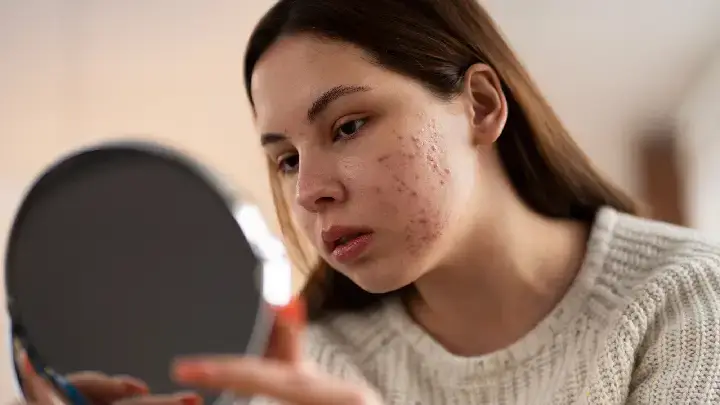Acne is among the most prevalent inflammatory conditions. Scar development is significantly affected by the severity and extent of skin inflammation. Scarring is more common in people who have inflammatory acne, which is characterised by a large number of pimples and cysts. Acne scar formation is an effect of poorly healed acne; everyone who has a breakout may get temporary or permanent scars, shares acne scar treatment doctor in Bangalore, Dr. Rasya Dixit.
Acne scars can make a person feel self-conscious or embarrassed about their skin. Makeup, oil, and dirt can clog pores, lead to acne scarring. External factors, such as food, pollution, stress, and hormones, can further exacerbate scarring. With the aid of advanced acne scar removal treatments, one can achieve the skin of their dreams. Read on to learn more about the acne scar treatment in Bangalore.
What are the types of acne scars?
Acne scars are categorised into three main types:
- Pigmented acne scars: These acne scars are at the same level as the skin and appear darker than the surrounding skin. They can be either black or red.
- Elevated acne scars: These scars appear above the surface of the surrounding skin and are caused by an excess of collagen during healing
- Depressed acne scars: These scars lie below the skin's surface. They occur when there is insufficient collagen production as the wound heals. There are three types of atrophic scars:
- Boxcar scars are large and U-shaped, with sharp edges. They could be shallow or deep. Skin resurfacing treatments work better on shallower pores.
- Ice pick scars are small, V-shaped, and can penetrate deep into the skin. They can resemble small, round, or oval holes, such as a chickenpox scar.
- Rolling depressions are wide with rounded borders and an uneven appearance.
What are the best treatments or ways for acne scar removal?
1. Microneedling radiofrequency: Micro-needling radio frequency (MNRF) is one of the well-known acne scar treatment solutions. Radiofrequency microneedling (RF microneedling) is a new technology that helps improve skin texture. It helps in rejuvenating skin and reducing acne scars. This is a minimally invasive technique that combines the microneedling procedure effectively with the element of radio frequency energy to rejuvenate the appearance of the skin. MNRF treats the target area through rapid penetration of insulated microneedles; however, it does not cause any extensive damage to the epidermis.
2. Peeling: Chemical peels are commonly used to treat pigmented acne scars. A chemical peel is a strong acid that works by removing the top layer of the skin, allowing new and healthy skin to form. Dermatologist Dr Rasya Dixit at Dr. Dixit’s Cosmetic Dermatology Clinic provides a chemical peel solution for best results.
This procedure offers a great way to maintain and rejuvenate the skin. Chemical peels are also used to lighten the hyperpigmented acne scars. Chemical peels like glycolic peel, ret-inol peel, and TCA peel remove the outer layer of old skin by using a special chemical solution. The new skin that replaces the old skin is usually smoother and less scarred.
3. Skin resurfacing: This procedure uses a laser to remove the scarred upper layers of skin and encourage new, healthy collagen to grow in its place. The procedure usually has a shorter recovery time than other resurfacing treatments. However, it is recommended to keep the area covered with a bandage until it is completely healed. This treatment is also not a viable option for anyone who is currently experiencing breakouts, and it is less effective on darker skin tones.
4. Dermal fillers: Fillers are injected into the skin to raise depressed areas of acne scars or stimulate the skin’s natural collagen production. Fillers can be used on areas of the face including the lips, nose, cheeks, chin, and around the mouth. Most fillers have collagen-sourced material, which adds volume to the skin, making indented scars look less noticeable, and small polymethyl methacrylate (PMMA) beads, which structurally support the skin and allow more collagen to develop.
5. Scar revision: Scar revision treatments are customised procedures that are formulated to improve the appearance of scars. Scar revision surgery depends on the type and severity of the scars.
6. Subcision: It is a minimally invasive, non-surgical procedure used for treating depressed scars. Subcision is well recognized as subcutaneous incisional surgery.
7. Growth Factor: It is a unique scar and anti-aging treatment used for overall skin rejuvenation. It uses the candidate’s blood to increase skin volume and rejuvenate the skin for natural-looking enhancements. This treatment is safe and effective for candidates with various skin types. It is a minimally invasive procedure.
8. IPL: IPL, also known as pulsed light therapy, involves a handheld device that emits pulses of broad-spectrum light through direct contact with the skin. This treatment targets the deeper layers of the skin, making it effective for improving the appearance of acne scars by stimulating collagen production and reducing redness and pigmentation.
One can also watch this video to learn more about acne scar treatments in detail with our dermatologist Dr. Dixit Cosmetic Dermatology Clinic -
Take Help of Acne Scar Doctor
First and foremost to achieve healthy scar-free skin, stop picking at pimples. Bacteria can increase the risk of future cyst formation and cause a larger scar to develop. Furthermore, dermatologists advise staying out of the sun, "as overexposure can darken scars, making them appear more noticeable," and to avoid hurting inflamed skin. Overwashing and scrubbing areas that are injured can reduce skin elasticity and make scars more noticeable. The sooner inflammatory acne is treated, the lesser the chances of scarring.
The best way to avoid acne scarring is to get medical assistance immediately from a dermatologist or acne scar doctor in Bangalore. Changes in skin texture, in particular, are more difficult to treat, so consult your dermatologist.


